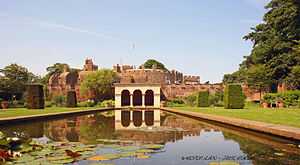Walmer Castle

Walmer Castle was built by Henry VIII in 1539–1540 as an artillery fortress to counter the threat of invasion from Catholic France and Spain. It was part of his programme to create a chain of coastal defences along England's coast known as the Device Forts or as Henrician Castles. It was one of three forts constructed to defend the Downs, an area of safe anchorage protected by the Goodwin Sands, in Kent, southeast England. The other forts were at Deal and Sandown.
The castle is now owned and managed by English Heritage.[1]
Design
At the centre of Walmer Castle is a circular keep, surrounded by an open courtyard and protected by a concentric wall, from which four, squat, semi-circular bastions project. The northern bastion forms the gatehouse and would have had a gun on its roof; the other bastions would have had guns mounted inside them and on the roof. The central keep would also have had guns mounted on its roof giving the castle the capacity to mount 39 guns. A gallery running around the castle at basement level has 32 loops for hand-guns covering the moat.
History
Tudors and Stuarts
The defences were never put to the test during the Tudor period, and it was not until 1648, during the English Civil War, that the castle finally came under siege. The three 'castles of the Downs' were initially held for Parliament, but the forces manning them switched allegiance to support the Royalist cause. It took Parliamentary forces, led by Colonel Rich, nearly three months to defeat the three castles, with Walmer surrendering first after a three-week siege.
Lord Warden's residence & gardens
In 1708 Walmer Castle took on a new role as the residence of the Lord Warden of the Cinque Ports. The Cinque Ports Confederation originated in the 11th century when the five ports of Hastings, Romney, Hythe, Dover and Sandwich joined forces to provide ships and men for the defence of the coast and protection of cross-channel trade. In return for these services they received substantial local privileges including immunity from all external courts of justice and from national taxation. In the 13th century the office of Warden was instituted to oversee and regulate the affairs of the Confederation. Initially this position carried real power, but with the formation of the Royal Navy and the decline of the Cinque Ports, the role of Warden became that of an honorary position bestowed on those who had given distinguished service to the state.

Over the years successive Wardens converted the fort and its grounds into a comfortable country house and gardens. Resident Wardens included William Pitt the Younger (whose niece Lady Hester Stanhope initiated the castle's gardens, using labour from the local militia), the Duke of Wellington (who died here), Sir Winston Churchill and Her Majesty Queen Elizabeth, The Queen Mother. Memorabilia from these past Wardens, including two rooms dedicated to the Duke of Wellington, can be viewed at the castle. The present warden is Admiral Lord Boyce.
See also
- Henry VIII: Legacy
- Device Forts
- Inventory of Henry VIII of England
References
Further reading
- Colvin, H. M. (ed.) (1982). The History of the King's Works, Vol. IV, 1485–1600, Part II.
- Harrington, Peter (2007). The castles of Henry VIII. Oxford: Osprey. ISBN 978-1-84603-130-4
- Lawson, Susannah (ed.) (2003). Walmer Castle and Gardens. London: English Heritage. ISBN 1-85074-726-1
- Morley, B. M. (1976). Henry VIII and the development of coastal defence. London: H.M. Stationery Office. ISBN 0-11-670777-1
External links
| Wikimedia Commons has media related to Walmer Castle. |
- Page at English Heritage
- Read a detailed historical record on Walmer Castle
- [http://www.english-heritage.org.uk/server/show/nav.00100200800k00800h English Heritage conservation]
- Information for teachers: English Heritage
| |||||||||||
Coordinates: 51°12′3.57″N 1°24′8.31″E / 51.2009917°N 1.4023083°E